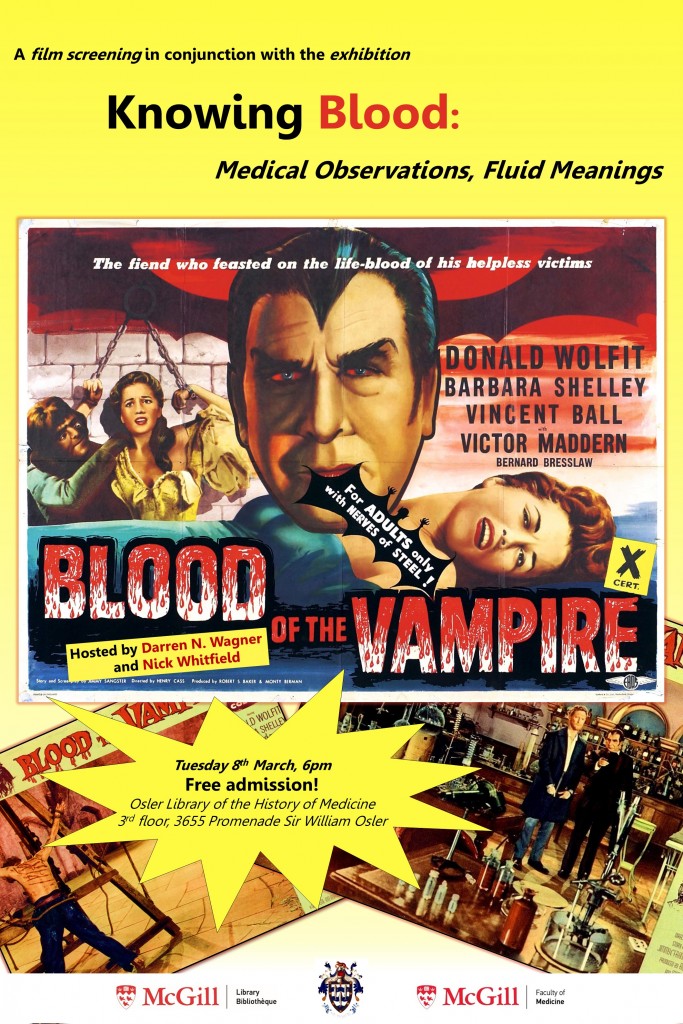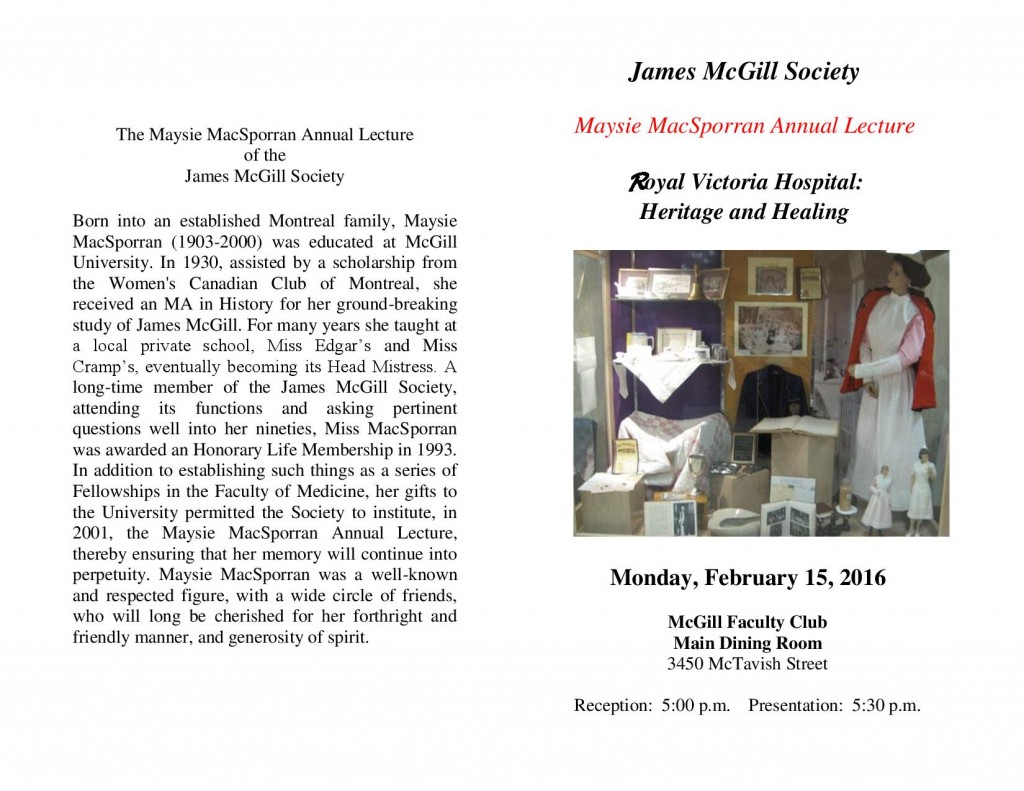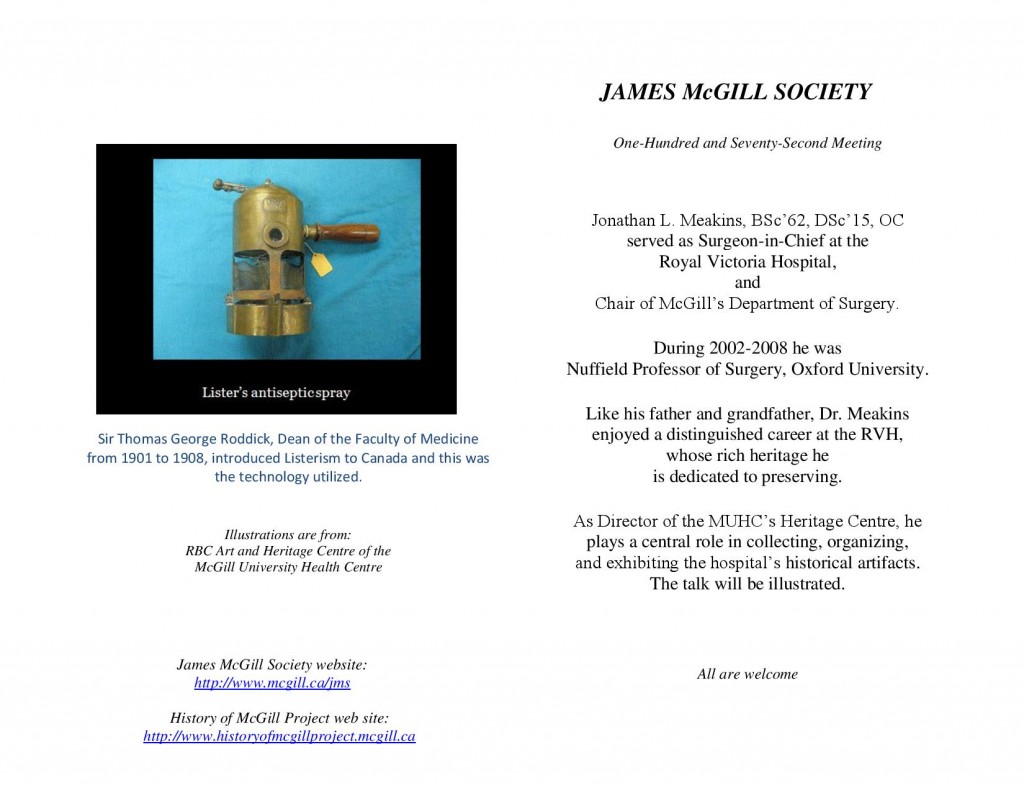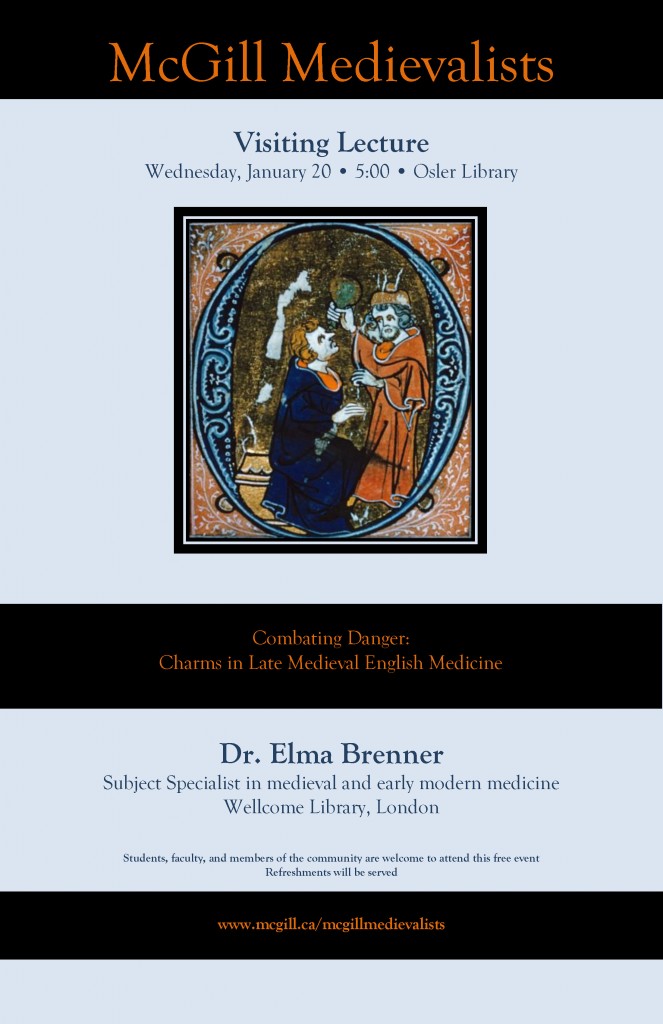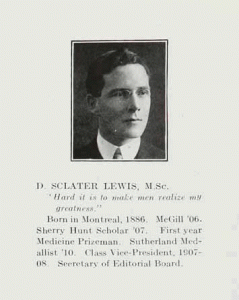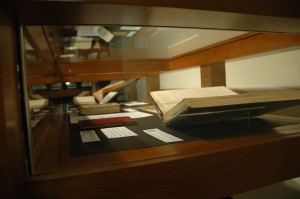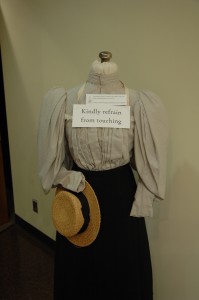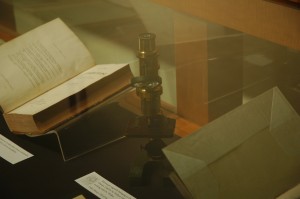A reminder to join us next week for a very special event!
Robert Palmer Howard (1912-1990) fonds
The library is in the process of adding a new Robert Palmer Howard (1912-1990) fonds to the archives. This will mark the most recent update to our Howard family collection, which already includes archival materials on Howard’s grandfather and namesake, Robert Palmer Howard (1823-1889), as well as his father, Campbell Palmer Howard (1877-1936).
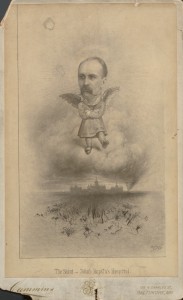
Max Brödel, “The Saint”, 1896. Artwork depicts William Osler’s head on an angel’s body over John Hopkin’s Hospital.
The new fonds consists of materials acquired and accumulated by Robert Palmer Howard including written correspondences between his father and close family friends such as Sir William Osler, Lady Grace Osler, and the Wright family. Also included are Osler family portraits, photographs of Osler at work, as well as a few drawings and sketches by Edward Revere (Osler’s son) and Max Brödel (the prominent medical illustrator who worked at John Hopkins School of Medicine).
After receiving his medical degree from McGill University in 1932, R. P. Howard spent most of his career as a physician and researcher at the Oklahoma Medical Research Foundation, affiliated with the University of Oklahoma. He maintained a particular interest in the history of medicine throughout his career and later became the director of University of Oklahoma’s History of Medicine Program. Upon retirement, he moved to Iowa City, IA to become Director of the History of Medicine Society at the University of Iowa.
As a medical historian and Oslerian, R. P. Howard held on to booklets, case studies, and pages of handwritten medical notes belonging to Sir William Osler, some of which are included in the new fonds.
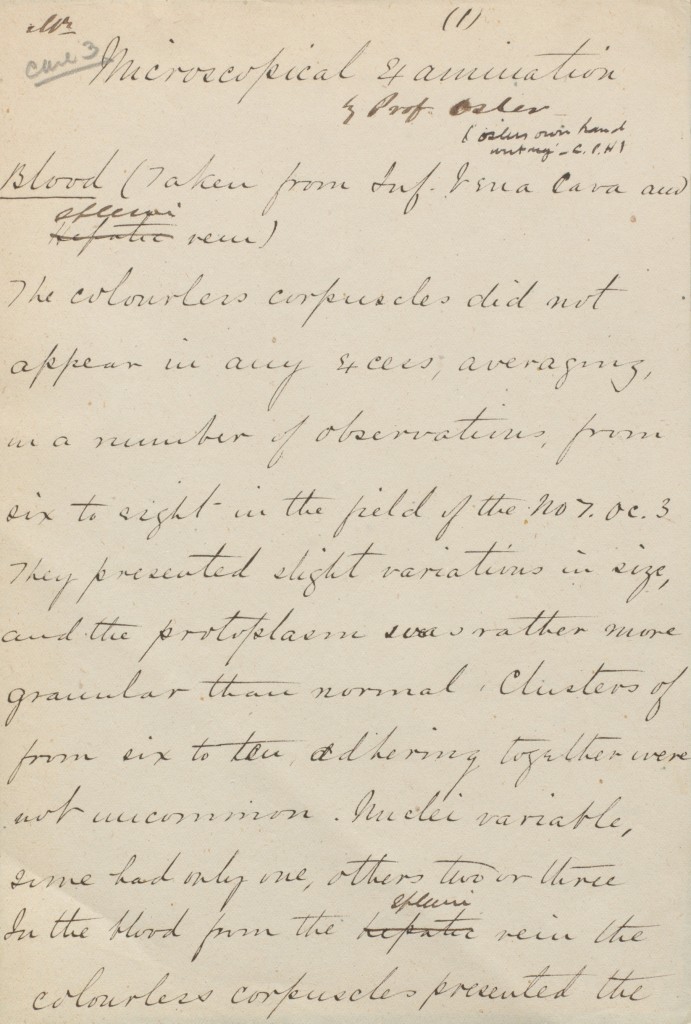
A page from William Osler’s medical notes, “Microscopical Examination”, 1875.
R. P. Howard was also the author of The Chief: Doctor William Osler published by Science History Publications in 1983. The bibliographical work provides a detailed account of the close relationships and correspondences between the Osler and Howard families. Visit the catalogue for more information on this regular loan item.
A special thank you to Caroline Howard Mast, daughter of Robert Palmer Howard, for generously donating the contents of this fonds to the Osler Library.
Royal Victoria Hospital: Heritage and Healing
The next meeting of the James McGill Society on February 15, 2016, will feature a talk on the “Royal Victoria Hospital: Heritage and Healing,” by Dr. Jonathan Meakins. All are welcome to attend.
Blood of the Vampire at the Osler Library
Please join us for a film screening Tuesday, March 8th, of the almost-cult classic BLOOD OF THE VAMPIRE (1958), held in conjunction with our latest exhibition, Knowing Blood: Medical Observations, Fluid Meanings.
From Wikipedia:
Transylvania in the 19th century. A young doctor John Pierre (Vincent Ball) and his fiancee Madeleine Duval (Barbara Shelley) are terrorized by Dr. Callistratus (Donald Wolfit) who was executed but has returned to life with a heart transplant. Along with his mute and hunchback assistant Carl (Victor Maddern), who is now fallen in love with Madeleine, the ‘anemic’ mad scientist, believed to be a vampire, conducts blood deficiency research on the inmates of a prison hospital for the criminally insane to sustain his return to life.
Health Art Exhibition: accepting submissions
“Wherever the art of Medicine is loved, there is also a love of Humanity.” – Hippocrates
 Health and illness are universal experiences that can be frightening and disorienting, yet also have the potential to inspire, transform, and heal. Out of this, there arises a need to express, make sense of, and derive personal meaning from what has been experienced. One of these ways is through art.
Health and illness are universal experiences that can be frightening and disorienting, yet also have the potential to inspire, transform, and heal. Out of this, there arises a need to express, make sense of, and derive personal meaning from what has been experienced. One of these ways is through art.
Artwork is currently being accepted for the Health Art Exhibition, which will be taking place winter 2016 at the MUHC Glen site hospital, with specific dates to be announced! To submit artwork for the exhibit: https://goo.gl/e6cE9C
Deadline for submissions: Friday, February 5, 2016.
For questions and further details, please contact 2015health.art@gmail.com.
https://
New exhibition: Knowing blood / Sang sens
 Knowing Blood: Medical Observations, Fluid Meanings
Knowing Blood: Medical Observations, Fluid Meanings
This exhibition is about observations, meanings, and understandings of blood from the late 15th to the mid-20th century. Blood has long been a powerful and evocative symbol, signifying themes from life, identity, community and kinship to sex, lineage, violence and death. Practices of observing blood in experiment, diagnosis, and therapy have also varied widely: a melange of cells seen under a microscope, a pulse felt by a trained touch, the taste of blood from a barber-surgeon’s bowl, a map comparing hematological and racial groups. Modern Western medicine has known not one but many kinds of blood.
Knowing Blood queries how various practices of observation have encountered the multifarious meanings of blood and negotiated new medical knowledge. The objects, texts, and images displayed here are drawn from the collections of the Osler Library of the History of Medicine, the Humanities and Social Sciences and Schulich Libraries, the Maude Abbott Medical Museum, and le Musée des Hospitalières de l’Hôtel-Dieu de Montréal. Five thematic cases highlight different historical approaches to observation, their relation to changing systems of medical practice and to blood’s broader meanings. We invite you to explore this rich 400-year history of knowing and observing the most vital of bodily fluids.
 Sang sens : observations médicales, interprétations fluides
Sang sens : observations médicales, interprétations fluides
Cette exposition porte sur l’observation, la signification et les représentations du sang de la fin du XVe au milieu du XXe siècle. Évoquant des thèmes de vie, d’identité, de communauté et de parenté, mais aussi de sexe, de génétique, de violence et de mort, le sang constitue depuis des siècles un symbole puissant. Les pratiques d’observation du sang dans les contextes expérimental, diagnostic et thérapeutique ont par ailleurs largement varié; depuis un mélange de cellules aperçu sous un microscope à un pouls tâté minutieusement, en passant par une certaine odeur détectée après une saignée ou encore une carte du monde comparant divers groupes hématologiques et raciaux. La médecine occidentale contemporaine a ainsi connu non pas un mais bien plusieurs types de sang.
Sang sens interroge les croisements multiples entre ces diverses pratiques d’observation et d’interprétation ayant contribué à la mise en place de nouveaux savoirs médicaux. Les objets, textes et images ici exposés sont tirés des collections de la bibliothèque Osler d’histoire de la médecine, de la bibliothèque des sciences humaines et sociales et de la bibliothèque Schulich, du Musée médical Maude Abbott, et du Musée des Hospitalières de l’Hôtel-Dieu de Montréal. Cinq vitrines thématiques mettent en évidence différentes facettes historiques de l’observation ainsi que leur relation avec les systèmes de la pratique médicale et les significations variées du sang dans divers discours. Nous vous invitons à découvrir cette histoire riche de 400 ans au sein de laquelle a été imaginé et montré le plus vital des fluides corporels.
The vernissage will be held on January 27th at 6PM and is open to all / Le vernissage aura lieu le 27 janvier à 18h et est ouvert a tous.
The exhibition is accessible during library opening hours, Monday-Friday, 9AM-5PM/ L’exposition est accessible pendant les heures d’ouverture de la bibliothèque, lundi à vendredi, 9h-17h.
Osler Library of the History of Medicine, McGill University, McIntyre Medical Building, 3655 Promenade Sir-William-Osler
Upcoming talk: Charms in late medieval English medicine
We are pleased to announce that one of our Edward H. Bensley Osler Library Research Travel Grant winners, Dr. Elma Brenner, will be speaking at the library on Wednesday, 20 January. Dr. Brenner, subject specialist in medieval and early modern medicine at the Wellcome Library in London, will give the talk “Combating Danger: Charms in Late Medieval English Medicine.”
5:00 PM, Wellcome Camera of the Osler Library of the History of Medicine. This talk is presented by McGill Medievalists.
New archival resources: D. Sclater Lewis and the history of the RVH
The library has recently finished describing a number of new accruals to the D. Sclater Lewis archival fonds (P105). Dr. Lewis was a medical graduate of McGill (MDCM 1912) and later Acting Physician-in-Chief at the Royal Victoria Hospital. The new archival documents include a draft manuscript of his 1969 Royal Victoria Hospital, 1887-1947, and substantial correspondence.
Sanitizing Style: A last chance to come visit!!
Our “Sanitizing Style” exhibition has been on display in the Osler Library since the beginning of September and will be be removed in the month of January, leaving just a few more days to come and see this fascinating exhibition. Sanitizing Style: Germ Theory and Fashion at the Turn of the Century explores the legitimacy that that the germ theory of disease lent to the late-nineteenth century movement to reform women’s dress. The exhibition brings together books, artifacts, images and clothing gathered from all around McGill University. Here are some examples of the material we have on show:
This exhibition is guest curated by Cynthia Tang, a PhD student in the History Department at McGill, and co-curated by Anna Dysert, Assistant Librarian at the Osler Library, with Catherine Bradley, Head of Wardrobe in the Theatre and Drama Program of McGill’s Department of English. The exhibition is accessible Monday through Friday from 9 am to 5 pm. Whether interested in history, fashion, immunology or even math, come and enjoy this exhibition before it goes!
Medical Students Essay Awards 2015

Pam and Rolando Del Maestro with Steph A. Pang (holding medal), Zhuyin Xu, and Christian Dabrowski. Photo: Owen Egan.
We are happy to announce that the winning essays from this year’s Pam and Rolando Del Maestro William Osler Medical Students Essay Awards are now available on our website, along with reflective pieces written by the students on their research experience.
First place went to Steph A. Pang for her essay entitled, “Man and his Health Pavilion: An Architectural Reinterpretation of the Patient-Doctor Relationship.” She was mentored by Prof. Annmarie Adams of the McGill School of Architecture and the Osler’s Library’s Board of Curators. She was presented with the Osler Library Board of Curators’ Medal during the Osler Banquet hosted by the McGill Osler Society on November 4.
Second place was awarded to Zhuyin Xu for her essay, “Diffusion of Medical Innovations: Minimally Invasive Surgery in China,” written under the mentorship of Prof. Thomas Schlich of the Department of Social Studies of Medicine.
Third place went to Christian Dabrowski for his essay, “Between Commitment and Contentment: the Story of Norman Bethune in Montreal.” He was mentored by Dr. Nicholas Whitfield of the Department of Social Studies of Medicine.
Congratulations to this year’s winners!
The Pam and Rolando William Osler Medical Students Essay Contest gives undergraduate medical students the opportunity to explore any theme of interest to them in the history, social studies, sociology, ethics, and humanities of the health sciences. It also provides them with the chance to be mentored by an expert in their topic drawn from the Library’s Board of Curators or elsewhere to complete their project, and to use the rich resources of the Osler Library and other libraries at McGill.To find out more about the contest, please visit our informational page.


